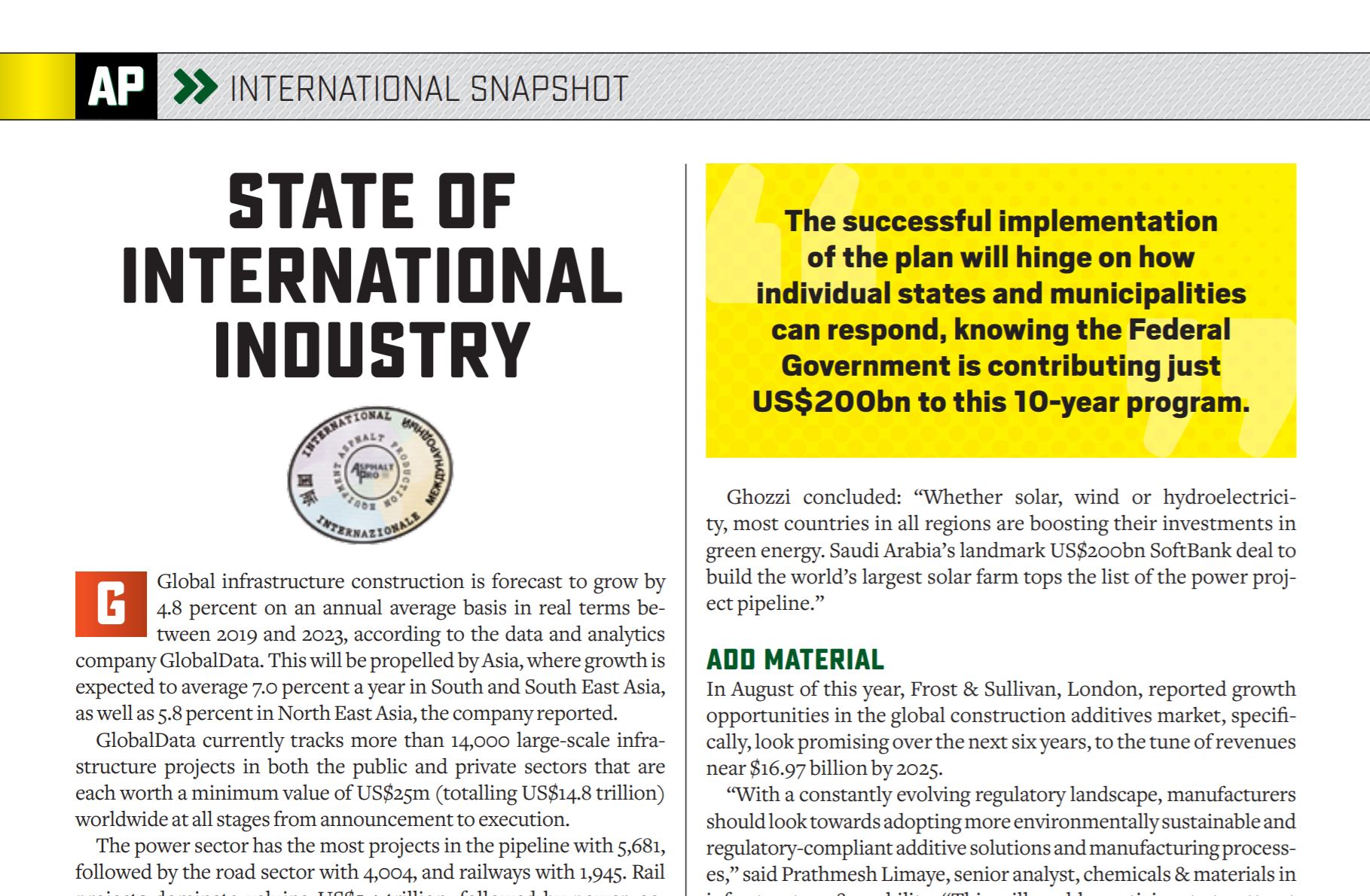Asphalt Industry Predictions for 2020–and Beyond
BY AsphaltPro Staff

Global infrastructure construction is forecast to grow by 4.8 percent on an annual average basis in real terms between 2019 and 2023, according to the data and analytics company GlobalData.
This will be propelled by Asia, where growth is expected to average 7.0 percent a year in South and South East Asia, as well as 5.8 percent in North East Asia, the company reported.
GlobalData currently tracks more than 14,000 large-scale infrastructure projects in both the public and private sectors that are each worth a minimum value of US$25m (totalling US$14.8 trillion) worldwide at all stages from announcement to execution.
The power sector has the most projects in the pipeline with 5,681, followed by the road sector with 4,004, and railways with 1,945. Rail projects dominate valuing US$5.4 trillion, followed by power, accounting for the second-largest sector valued at US$4.7 trillion, and roads at US$2.6 trillion.
When completed, the tracked road projects will comprise a total 186,993km under construction (or expansion/renewal) in the next five years. The most notable road expansion in terms of total length is taking place in South and South East Asia, with a total of 59,835km of ongoing and upcoming road projects spread across the region. A total of 160,198km of railway track and 1,271.6GW of generating capacity will be undertaken and completed in the next five years.
Yasmine Ghozzi, economist at GlobalData, said: “In Sub-Sahara Africa and the Middle East and Africa (MEA), where infrastructure construction growth is expected to average 7.3 percent and 6.6 percent, respectively, there are huge infrastructure upgrades underway in roads, railways and power generation.
“The pace of growth in North America and Europe’s construction industry will perform better in the forecast period than the previous forecast, 2014 to 2018—albeit slower than emerging markets. Electricity and power infrastructure will be one of the fastest sectors in Europe as countries across the continent reaffirm their commitment to advance the implementation of the Paris Agreement and intensify their cooperation on climate change and clean energy.”
U.S. President Donald Trump’s US$2 trillion infrastructure plan will undoubtedly provide support for the overall growth of the North America region’s industry in the next five years. However, the successful implementation of the plan will hinge on how individual states and municipalities can respond, knowing that the Federal Government is contributing just US$200bn to this 10-year program.
Ghozzi concluded: “Whether solar, wind or hydroelectricity, most countries in all regions are boosting their investments in green energy. Saudi Arabia’s landmark US$200bn SoftBank deal to build the world’s largest solar farm tops the list of the power project pipeline.”
In August of this year, Frost & Sullivan, London, reported growth opportunities in the global construction additives market, specifically, look promising over the next six years, to the tune of revenues near $16.97 billion by 2025.
“With a constantly evolving regulatory landscape, manufacturers should look towards adopting more environmentally sustainable and regulatory-compliant additive solutions and manufacturing processes,” said Prathmesh Limaye, senior analyst, chemicals & materials in infrastructure & mobility. “This will enable participants to attract customers that are focused on high durability and environmental sustainability as well as harness lucrative revenues in the more mature markets of Western Europe and North America.”
From a regional perspective, Asia-Pacific is expected to be the biggest market for construction additives and the fastest growing sector due to industrialization, urbanization and high economic growth. These factors are also expected to boost growth in Latin America. Europe will witness robust demand for construction additives due to new construction activities within Eastern Europe and remodeled construction in Western Europe. Furthermore, the Summer Olympics in Paris in 2024 are expected to expand France’s infrastructure prospects.
“North America will witness the slowest growth among the regions, as the construction activity is still affected by the 2008 recession; however, it is slowly picking up,” Limaye noted. “The Middle East is anticipated to witness strong growth with the Dubai World Expo in 2020 and Qatar FIFA World Cup in 2022 acting as key enablers.”
Limaye recommended participants look towards the development and supply of products that can be manufactured with locally sourced raw materials to enable the supply of price-competitive products. This will avoid dependency on traditional manufacturing practices, which have the potential to be restricted in the future by regulatory authorities. They should also aim to strengthen relationships with major applicators and distribution networks by offering training and collaborative product development.
